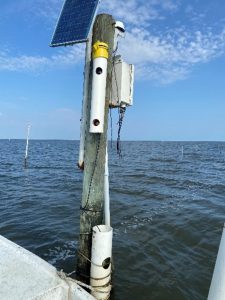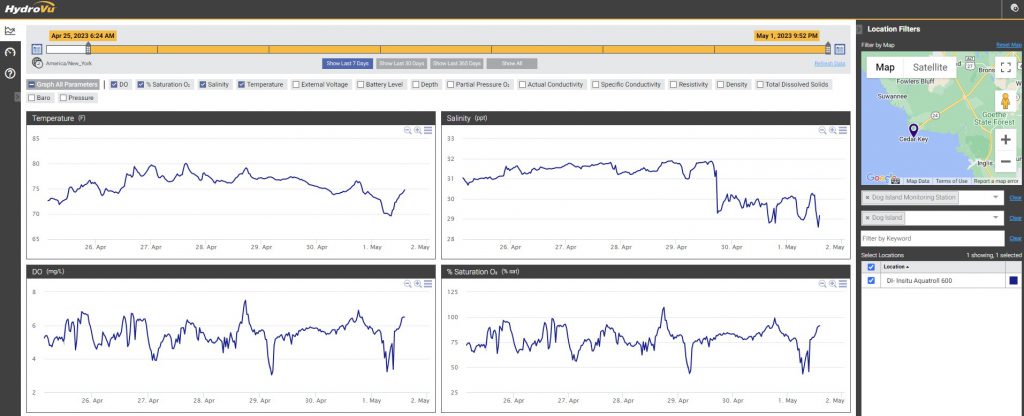
Important information about water quality is available to the shellfish aquaculture industry and interested people. The information at selected monitoring stations can be used real-time by growers and seed producers in making immediate management decisions. Archived information at additional stations can be used in comparing annual and seasonal differences in shellfish production as well as substantiating crop losses. This decision support tool is the result of a cooperative partnership among the University of Florida (UF) IFAS and industry members.
 Real-time Monitoring in Cedar Key
Real-time Monitoring in Cedar KeyCurrently, real-time water quality monitoring stations are operated at two shellfish aquaculture use zones near Cedar Key – Dog Island and Gulf Jackson AUZs. Information is collected using In-Situ Aqua TROLL 600 multiparameter sondes, which measure water temperature, salinity, dissolved oxygen, and depth every half hour, 24-hours a day, seven days a week. Every two hours the measurements are posted to a website dashboard via HydroVu Data Services. The stations undergo regular maintenance by UF staff in Cedar Key.
In 2023, Oyster FARMS (Farms for Aquaculture Research & Monitoring of Shellfish) was initiated, and a network of growers was formed across the state to increase monitoring efforts in response to mortality events. Water temperatures and salinities are continuously monitored at commercial farms located in the following water bodies: Alligator Harbor, Apalachicola Bay, Indian River, Indian Lagoon, Mosquito Lagoon, Oyster Bay, Skipper Bay, and Pensacola Bay. At six of the farms, In-situ Aquatroll 100 dataloggers are placed inside oyster bags. Measurements are taken hourly. Growers maintain loggers routinely and download data via Bluetooth to a mobile app, which are posted to a dashboard by UF staff. At Alligator Harbor and Oyster Bay, the FSU Coastal and Marine Laboratory maintains real-time monitoring stations using YSI EXO multi-parameter sondes.
Cedar Key Real-time Dashboard: Real-time or “live” information can be viewed here: https://shellfish.ifas.ufl.edu/water-quality-data-insitu/. Information is posted every two hours and the most recent seven days is shown. Data are not error corrected.
Oyster FARMS Archived Dashboard: Data submitted by growers can be viewed here: https://shellfish.ifas.ufl.edu/farms-2023/water-quality-data/. Information is posted monthly and the most recent seven days is shown. Data are not real-time (“live”) or error-corrected.
Viewing Dashboard Data: Users have the ability to show the last 7 days, 30 days, 365 days, or all data. Additionally, users can click on the dashboard icon on the left-hand side to view latest readings.

Archived Data: All data are archived and made available in “farmer-friendly” graphic format. Archived data are error-corrected by UF extension faculty.
To assist growers and others interpret water quality values, a series of fact sheets on the role of water temperature, salinity, and dissolved oxygen on hard clam production was developed by UF faculty and graduate students. Topics include: how the water quality parameter is measured, why it is variable, how does it affect clam physiology, and what are the signs of stress in clams. Information is also provided on how to manage clam crops in response to water quality parameters.
Installation and operation of water quality monitoring stations at nine shellfish aquaculture lease areas in Florida began in 2002 as part of the CLAMMRS (Clam Lease Assessment, Management, and Modeling using Remote Sensing) project, funded by the U.S. Department of Agriculture (USDA). Lease locations included Alligator Harbor, Body A, Body F, Dog Island, Gulf Jackson, Horseshoe Beach, Indian River, Pine Island, and Sandfly Key. Continuous monitoring over a four-year period documented environmental conditions that could influence clam survival and growth. A final report on the CLAMMRS project is available here.
From 2006 through 2012, a partnership agreement with the USDA National Institute of Food and Agriculture (NIFA) and USDA Risk Management Agency (RMA) allowed for continued operation of stations. After which, a lack of funding resulted in most of the stations being dismantled. The UF/IFAS Shellfish Extension Program continues to maintain the stations at Dog Island and Gulf Jackson lease areas near Cedar Key.
ARCHIVED
Water Quality Information